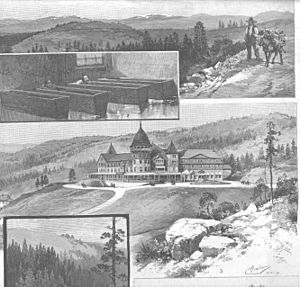Montezuma, New Mexico facts for kids
Quick facts for kids
Montezuma, New Mexico
|
|
|---|---|

Partial page from Harpers's Weekly, 1890, describing Las Vegas Hot Springs (now Montezuma, NM). Upper image is "Mountain View near the Springs". First inset is "Taking a Mud Bath". Third image is "The Montezuma", and the top of "View in the Cañon" appears to the lower left.
|
|
| Country | United States |
| State | New Mexico |
| County | San Miguel |
| Elevation | 6,719 ft (2,048 m) |
| GNIS feature ID | 908848 |
Montezuma is a small community in San Miguel County, New Mexico, United States. It's about five miles northwest of the city of Las Vegas. For a long time, Montezuma was famous for its natural hot springs. People even called it "Los Ojos Calientes," which means "The Hot Springs" in Spanish. Today, Montezuma has ranches, a post office, and a special school called the United World College-USA. The ZIP Code for Montezuma is 87731.
Contents
The History of Montezuma
Early Hot Springs Use
Long ago, Native Americans knew about the hot springs in Montezuma. They believed the waters had healing powers. The springs became a business in 1840. A man named McDonald asked the Mexican government for the land. He got it by agreeing to become a Mexican citizen. He then built a house near the springs and charged people to use them.
Hotels and the Railway
In 1846, the U.S. Army took over New Mexico from Mexico. A military hospital was set up near the hot springs. This hospital became a hotel in 1862. In 1879, the Santa Fe Railway bought the springs. They built a stone hotel there, which was called the "Hot Springs Hotel." This building is still standing and is used by the United World College-USA. Even famous people like Jesse James stayed there.
The Santa Fe Railway also built a special train track from Las Vegas to Montezuma. This track helped bring tourists to the hot springs. It also carried ice from six ponds near Montezuma. This ice was used to keep vegetables fresh on trains going to eastern markets.
The Montezuma Castle Hotel
Between 1881 and 1882, the Atchison, Topeka and Santa Fe Railway built a very large hotel. They even renamed the town "Montezuma." Sadly, this first hotel burned down. A second, even grander stone hotel was built, but it also burned.
The final hotel, built in 1886, is still there today. It is known as the Montezuma Castle and is considered a "national treasure." The railway company published books about the hotel. They described it as a beautiful four-story building made of sandstone. It had lovely views of the mountains and a big lawn with gardens and sports areas.
Changing Owners of the Hotel
The Montezuma Hotel closed in 1903. Later, floods destroyed the bath house. The railway company eventually sold the property to the Y.M.C.A. for just $1. The Y.M.C.A. then sold it to the Baptist church. From 1923 to 1932, the building was used as a college.
After that, the Baptist church tried different businesses in the building, but none worked out. The property was then sold to the Catholic church. From 1937 to 1972, it was a training center for Mexican priests. Today, it is home to the United World College-USA.
Montezuma's Location and Springs
Where Montezuma Is
Montezuma is located along the Gallinas River. It sits within the beautiful Sangre de Cristo Mountains. It's also only a few miles from a famous peak called Hermit's Peak.
How the Hot Springs Work
The water for the Montezuma Hot Springs comes from rain and melting snow. This water falls on the Sangre de Cristo Mountains. It then soaks into the ground through cracks in the rocks. The water travels deep underground to the Gallinas Canyon.
Scientists have different ideas about how the water gets hot. One idea is that the Earth's natural heat warms the water as it goes deeper. Another idea is that heat from ancient rocks or even magma from volcanoes in northeastern New Mexico warms the water.


